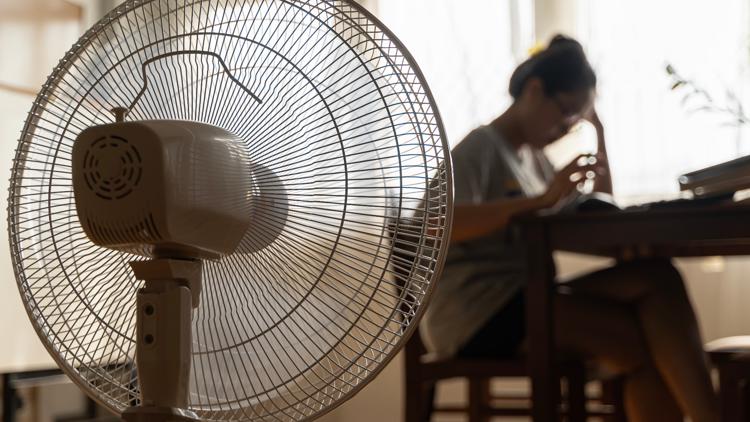During the summer months, heat waves bring scorching temperatures to areas throughout the United States.
For people who live in homes or apartments without air conditioning, the extreme heat is even more miserable.
The Red Cross and other experts recommend going to a public library, shopping mall or public cooling center to stay safe in high temperatures if you do not have air conditioning.
But what should you do if you have to be at home during a heat wave? Here are six VERIFIED things you can do to stay cool without air conditioning.
THE SOURCES
- U.S. Department of Energy
- Lowe’s
- Oregon Department of Energy
- Five Seasons Windows and Doors, a window and door installation service in Colorado
- Sleep Foundation
- Rhode Island Department of Health
- Home Depot
- Energy Star, the federal government’s energy efficiency program.
- Emergency Ice, an ice supplier based in Texas
- Article published by Columbia University’s Climate School
- British Red Cross
- Pennsylvania Public Utility Commission
WHAT WE FOUND
1. Close your blinds and curtains during the day.
Closing your blinds and curtains is a proven way to keep your home cooler if you don’t have air conditioning.
According to the U.S. Department of Energy, 76% of the sunlight that hits a standard double pane window turns into heat. The agency recommends turning your blinds upward or shutting them all the way to reduce the amount of heat coming into your home.
Lowe’s says closing curtains or blinds that face south and west during the daytime and picking white window treatments will help deflect even more heat.
In an emergency situation, you can put aluminum foil-covered cardboard over your windows to combat extreme heat. The aluminum foil reflects the sun’s rays away from your windows, minimizing any heat absorption.
2. Open windows and use fans at night to create a cross-breeze.
If temperatures cool down at night, the Oregon Department of Energy recommends opening windows on opposite sides of your home to create a cross-breeze.
“When windows are opened on both sides, it allows for a breeze to flow through, pushing out warm, stale air and drawing in cooler, fresh air,” Colorado-based Five Seasons Windows and Doors says.
Fans can also help boost ventilation by moving air around when wind or natural cross-breezes are limited, the Sleep Foundation says.
You can use one electric fan to pull cool air into your home and a second fan to blow hot air out, which will also create a cross-breeze, according to the Rhode Island Department of Health.
3. Set your ceiling fan to spin counterclockwise.
Circulating fans, including ceiling fans, create a wind-chill effect that helps people feel cooler, even though the fans don’t lower the temperature of the room, the U.S. Department of Energy (DOE) says.
But for optimal effectiveness, your fan needs to spin counterclockwise in the summer because the blades will push cooler air down in a column, according to Home Depot and Energy Star, the federal government’s energy efficiency program.
A ceiling fan spinning in the correct direction can also save money, because people can raise their thermostat by about four degrees without feeling warmer, thanks to the fan’s cooling effect.
To change your ceiling fan’s direction, check for a small switch beneath the blades and click it to make the fan rotate counterclockwise.
4. Buy an evaporative cooler or make a simple DIY version.
The Sleep Foundation recommends buying an evaporative cooler, which will “cool and humidify the air as it enters your home by moving it over a series of wet pads.” Evaporative coolers are most effective if you live somewhere with low humidity.
But evaporative coolers can be pricey, with some of them costing hundreds of dollars.
If one of these coolers isn’t in your budget, you can make a DIY version using a non-oscillating floor fan and a large bowl of ice.
Once you’ve filled your bowl with ice, place it at an angle in front of the fan, an article published by Columbia University’s Climate School says. The fan will draw in air that has been chilled by the ice, sending a cool breeze your way.
5. Place a cold washcloth or ice pack on your pulse points.
Experts recommend putting something cold, like an ice pack, on your pulse points to stay cool. This can help lower body heat since the blood vessels in these areas are close to the skin’s surface.
Columbia’s Climate School says there are pulse points on your wrists, neck, elbows, ankles, feet, inner thighs, temples, forehead and groin, as well as behind your knees.
If you don’t have an ice pack handy, you can make your own by wetting a towel or shirt and leaving it in the freezer for a few hours, the Sleep Foundation says.
6. Try to avoid using appliances that give off a lot of heat.
If you want to stay cool, you should try to avoid using large appliances that give off a lot of heat, including your oven, stovetop, washer, dryer and dishwasher, our experts say.
The Pennsylvania Public Utility Commission recommends using a microwave oven instead of your conventional range or oven.
If you do have to wash your clothes, use cold water whenever possible, the agency says. You should also use your clothes dryer or dishwasher early in the morning or later in the evening rather than during the heat of the day.
You may also want to consider unplugging large electronic devices, such as televisions, that produce a lot of heat, the Rhode Island Department of Health says.
This story is also available in Spanish / Lee este artículo también en español: Cómo mantenerse fresco sin aire acondicionado en este verano: 6 Datos Breves



